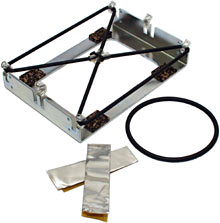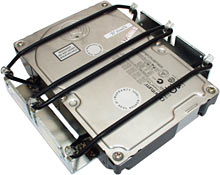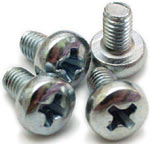
NoiseControl NoVibes III
Review date: 10 September 2001.Last modified 03-Dec-2011.
Performance computing and blissful silence are two things that don't commonly go together. Modern PC CPUs all need fan-forced cooling, many current video cards have fans on them too, cases have fans to keep cool air moving through them. And then there's the drives.
Different hard drives have different noise levels. Many current drives, particularly slower models, are pretty quiet. High speed SCSI howlers commonly aren't, though. And even the quiet drives generate significant vibration as they spin, and as the read/write head assembly zips back and forth across the platters.
When a drive's firmly screwed into a computer case, as they normally are, any vibration it generates is coupled very efficiently to the whole case. The lightweight side panels then couple it pretty efficiently to the air.
Result: Noise.
There are various gizmoes that let you mount a 3.5 inch hard drive in a 5.25 inch drive bay, and some of them make the drive quieter in the process.
Basic mounting kits are just plain bracket sets, which screw to both drive and bay and provide no vibration isolation to speak of. They're still handy, because they let you install another 3.5 inch drive even if you've run out of 3.5 inch bays, and they also give you air space around the drive for better cooling. And they don't cost much. But they don't make your computer quieter.
Other 3.5-to-5.25 gadgets actually make your computer louder, with a row of dinky little fans in front of the drive to help keep it cool. These fans are, invariably, not very powerful compared with ordinary 80mm case fans; it's generally a better idea to just have a grille in front of your hot drives, and some powerful exhaust fans at the back of the case. They'll pull air over the drives more efficiently than titchy fans could push it.
Some drive bracket arrangements do have drive-silencing functions, though. The most extreme of them seal up the drive in the equivalent of an old-fashioned printer hutch, with sound insulation on the inside. These things have to have fans, though, to stop the poor insulated drive from dying of heat prostration. If the little fans conk out, so, in short order, will the drive.
Other noise-reducers just vibration-isolate the drive from the case, typically with rubber grommets around mounting screws.
NoiseControl thought about that idea, and improved it.
The NoiseControl NoVibes III is made to hold a drive in place not with screws, but with taut rubber O-rings, which strap the thing in place. There's no sound insulation around the drive, but it ends up very well isolated from the case as far as vibration goes.
The NoVibes III sells for 241 Norwegian kroner, which is a bit more than $US27 or $AU52, as I write this.
The NoVibes III package contains the main metal frame, which has six padded hooks on the side of it. Four of the hooks have hefty O-rings (reminiscent of the strings of an Ashbory bass) hooked over them already. There's one more O-ring provided, which you hook on after you've slid in your drive.
You also get a couple of strips of self-adhesive metal tape, whose purpose wasn't immediately obvious to me. I thought the tape might be for padding sharp edges on some drives, to protect the O-rings, and that guess has now been confirmed.
The reason I wasn't sure was because the double-sided one-page instruction sheet for the NoVibes III is in German. Which means it's gloriously headed "Montageanleitung Schwingungsgedämpfter Festplattenrahmen". Which, Babelfish informs me, means "Assembly instruction of oscillation-absorbed fixed disk frameworks".
The NoVibes IIIs I got to play with came from Microplex in Norway, but NoiseControl is a German outfit; hence the instructions auf Deutsche.
Fortunately, the instruction sheet illustrations make the installation process pretty clear.
Setting up
Putting a drive into the NoVibes III is very simple, provided you've got the right kind of drive, which you probably have. It only works with 3.5 inch half height devices, with the normal plain rectangular-prism shape. Drives with drastic cut-outs on the side or unusually sharp edges need extra spacer rails, which can be bought separately. Full-height monster-drives won't fit at all, unless you provide your own larger O-rings.
If your drive suits the NoVibes, you just thread it through the two linked pre-installed O-rings, so that the crossed-over connection of the two is on the bottom of the drive. And then you hook the third ring on over the top. Easy.
The drive isn't entirely supported by the taut rubber; it also rests on little chunks of the evocatively named "NoiseControl ShutUp" material, which looks like a cork/rubber composite mat.
The final mounting is pretty secure. You could poke the drive out of the NoVibes without too much trouble, but I strongly doubt that it'll be able to shift to any great degree in normal transportation of the computer. It's certainly not going anywhere when the PC's just sitting in one place. The vibration-isolated mounting may even be a plus when you're moving the PC; less shock will make it to the delicate drive assemblies if the PC's shaken or knocked. A NoVibes rig would also make a drive less susceptible to problems if the PC's used in a high-vibration environment, though it's far from a proper "toughened" setup.
When you've got your drive mounted, you just have to screw the NoVibes frame into a 5.25 inch bay, like any other drive adapter.
For this purpose, you get some high quality mounting screws in the NoVibes bag, too.
Effectiveness
So does it work?
Yes.
The NoVibes III does, indeed, remove the thrum of the drive motor that gently vibrates even the quietest normal PC. How much of a difference the thing will make to your computer depends, of course, on how many other noisy things the box contains. But if you're running a quiet PC already - either a low-powered box that doesn't need lots of fans, or a monster machine kitted out with quieter than usual fans, which can also be rubber-mounted without a great deal of effort - then the NoVibes is worthwhile.
The NoVibes III also, of course, gives you all of the drive cooling benefits of a regular 3.5-to-5.25 rack. If you perforate or just remove the bay cover in front of the drive, your rear fans will be able to suck cool air over the drive much more effectively than they could with it in the average 3.5 inch bay.
Many people putting 10,000RPM+ SCSI drives in normal PC cases will be mounting them in some kind of 5.25 inch adapter anyway, to give them decent cooling. If you've got more than one such drive, investing in as many NoVibes racks as you have drives could make a quite noticeable difference to the loudness of your computer, even if you don't pay special attention to quietening the rest of the setup.
Overall
The NoVibes III seems a pretty elegant design. The O-rings are made of quality rubber and shouldn't perish, the frame is solid, the instruction sheet is well enough illustrated that not being able to read German isn't likely to be a big handicap. And it looks nice, too.
You'll pay a lot more for a NoVibes III than you will for a basic two-piece adapter rail package, of course; $AU7.50 will cover one of those kits, delivered.
But if you want an easy to install vibration isolator that doesn't mummify your drive and put its life at the mercy of some little fans of unknown provenance, the NoVibes III is well worth the money.
Review NoVibes IIIs kindly provided by Microplex Norge AS





